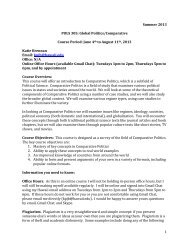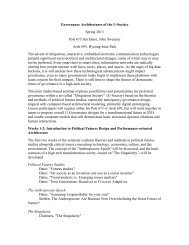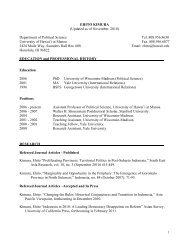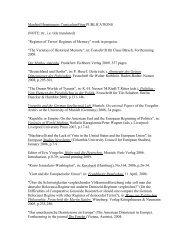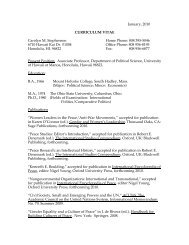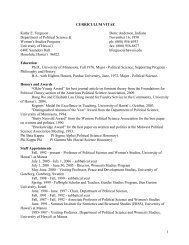POLITICS OF THE FUTURE Jim Dator PolSc 672 Fall 2010 ...
POLITICS OF THE FUTURE Jim Dator PolSc 672 Fall 2010 ...
POLITICS OF THE FUTURE Jim Dator PolSc 672 Fall 2010 ...
Create successful ePaper yourself
Turn your PDF publications into a flip-book with our unique Google optimized e-Paper software.
<strong>POLITICS</strong> <strong>OF</strong> <strong>THE</strong> <strong>FUTURE</strong><br />
<strong>Jim</strong> <strong>Dator</strong> <strong>PolSc</strong> <strong>672</strong> <strong>Fall</strong> <strong>2010</strong><br />
Department of Political Science<br />
University of Hawaii at Manoa<br />
http://www.futures.hawaii.edu<br />
(April 27, <strong>2010</strong> version. Detailed syllabus with readings to follow)<br />
This course is a graduate-level introduction to futures studies from a political science<br />
perspective. It serves as the introductory core course for students of the Alternative<br />
Futures MA option in the Department of Political Science, and for anyone else interested<br />
in learning what futures studies is and is not.<br />
Unlike recent versions of Pols <strong>672</strong>, this course will focus on learning and using<br />
some of the major theories and methods of futures studies.<br />
8/25. Introduction to the course and to each other. Some key terms and concepts<br />
Assign: Come to class on September 1 prepared to introduce briefly a theory of<br />
social change.<br />
9/1. Overview and discussion of various theories of social stability and change.<br />
9/8 and 15. What is "technology" and how can it be a key agent of social stability and<br />
change?<br />
9/22 and 29. A brief historical survey of the rise of futures studies and the various<br />
"schools" and uses of futures studies, with an emphasis on "The Manoa School".<br />
10/6. The importance of the past and present in anticipating the futures: Using STEEP,<br />
Delphi, and trend analysis to identify "driving forces" from the past and present pushing<br />
society into the futures.<br />
10/13. Using environmental scanning and emerging issues analysis to identify things that<br />
might/will break the "trends" and create new problem/opportunities.<br />
10/20. The key role of "images of the future" in futures studies and in anticipating<br />
alternative futures.<br />
10/27. Grow, Collapse, Discipline, Transform: the four generic images of the futures.<br />
Developing and using the four generic alternative futures scenarios . Written and other<br />
forms of presentation.<br />
Assign: Find, develop scenarios for, and present on 11/3 an "emerging issue".<br />
11/3. Presentation and discussion of emerging issues.<br />
Assign: Form research teams and begin developing alternative futures scenarios,<br />
based on the theories and methods presented in this class.<br />
11/10. Group Research
11/17. Group Research<br />
11/24. Group inclass reports<br />
12/1. Group inclass reports<br />
12/8. Planning and conducting a futures visioning process to help a community create<br />
preferred futures. Linking futures to planning, policy, and day-to-day decision-making<br />
and administration.<br />
12/15. Individual final projects due: "Alternative Futures of X"



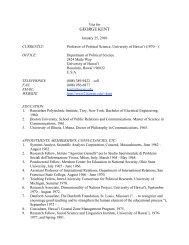
![Fall 2012 POLS 620 Syllabus [PDF] - Department of Political Science](https://img.yumpu.com/25416938/1/190x245/fall-2012-pols-620-syllabus-pdf-department-of-political-science.jpg?quality=85)


